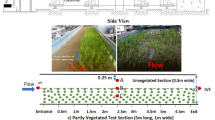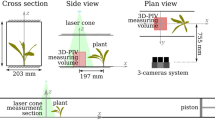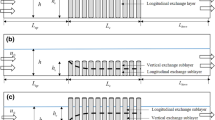Abstract
Floating vegetated islands (FVIs) are extensively implemented in various river ecology restoration projects, given their capability of decontaminating pollutants. The fluid dynamical behaviors of turbulence through FVIs are studied in the flume by using the SonTek Acoustic Doppler Velocimetry. Through conventional spectral and quadrant analyses, flow characteristics, such as energy content and turbulent momentum exchange, are investigated as the flow encountered a series of root canopies. A shear layer with corresponding coherent vortex structures at the bottom of root canopies occurred, which is generated by Kelvin–Helmholtz instabilities. These instabilities are usually derived from velocity differences between root canopy and gap region. Shear- and stem-scale vortices are identified by using spectral analysis. The power spectral density function on measured vertical velocity fluctuations in the flow direction near the bottom of root canopies from the leading edge of FVIs is computed. Given the flow developing downstream, a series of the spectral curves has gradually showed one dominant dimensionless frequency at 0.046. The sweep and ejection events have contributed prominently to the Reynolds stress in whole vertical direction. Momentum flux carried by sweeps outweighs its counterpart carried by ejections inside root canopies. However, the situation is different outside root canopies. The sweep–ejection contributions are brief but crucial to the total turbulent momentum exchange, which is in good agreement with considerable studies on turbulent flow through canopies.















Similar content being viewed by others
Abbreviations
- a :
-
root canopy density (m−1)
- n :
-
number of cylinders per bed area (m−2)
- d :
-
cylinder diameter (m)
- s :
-
vegetation spacing (m)
- S 0 :
-
channel bed slope (vertical:horizontal) (-)
- Q :
-
flow rate (m3/s)
- b :
-
width of floating vegetated islands (m)
- B :
-
flume width (m)
- h r :
-
height of root canopy (m)
- h g :
-
height of gap region (m)
- H :
-
flow depth (m)
- H p :
-
Penetration depth (m)
- L veg :
-
length of floating vegetated islands (m)
- ν :
-
Kinematic viscosity (m2/s)
- g :
-
Gravitational acceleration (m/s2)
- x, y, z :
-
streamwise, lateral and vertical directions (-)
- U, V, W :
-
time-averaged velocity components in x, y, z directions (m/s)
- u, v, w :
-
instantaneous velocity components in x, y, z directions (m/s)
- u΄, v΄, w΄ :
-
fluctuating velocities in x, y, z directions (m/s)
- u ∗b :
-
bulk friction velocity (m/s)
- U m :
-
cross-sectional average streamwise velocity of the flow (m/s)
- U a :
-
characteristic streamwise velocity in Eq. (3) (m/s)
- U d1 :
-
stable time-averaged streamwise velocity in high-stream velocity layer (m/s)
- U d2 :
-
stable time-averaged streamwise velocity in low-stream velocity layer (m/s)
- 〈U〉:
-
arithmetic average of Ud1 and Ud2 (m/s)
- ΔU :
-
velocity difference between Ud1 and Ud2 (m/s)
- Re :
-
bulk Reynolds number (-)
- Fr :
-
bulk Froude number (-)
- St :
-
Strouhal number (-)
- R H :
-
hydraulic radius (m)
- T KE :
-
turbulent kinetic energy (m2/s2)
- θ :
-
momentum thickness (m)
- δ :
-
mixing layer thickness (m)
- \( -\overline{u^{\prime }w^{\prime }} \) :
-
Reynolds stress with respect to vertical plane (m2/s2)
- S ww :
-
power spectral density (cm2/s)
- H 0 :
-
threshold value (-)
- \( {{S_i}_{,}}_{H_0} \) :
-
contribution of various flow types to Reynolds stress (cm2/s2)
- \( {{C_i}_{,}}_{H_0}(t) \) :
-
averaging condition in Eq. (4)
References
Ai YD, Liu MY, Huai WX (2020) Numerical investigation of flow with floating vegetation island. Journal of Hydrodynamics 32(1):31–43
Borne KE (2014) Floating treatment wetland influences on the fate and removal performance of phosphorus in stormwater retention ponds. Ecol Eng 69:76–82
Downing-Kunz M, Stacey M (2011) Flow-induced forces on free-floating macrophytes. Hydrobiologia 671(1):121–135
Ghisalberti M, Nepf HM (2002) Mixing layers and coherent structures in vegetated aquatic flows. J Geophys Res Oceans 107(C2):3011
Ghisalberti M, Nepf HM (2004) The limited growth of vegetated shear layers. Water Resour Res 40:W07502
Goring DG, Nikora VI (2002) Despiking acoustic Doppler velocimeter data. J Hydraul Eng-ASCE 128(1):117–126
Keddy PA (2010) Wetland ecology: principles and conservation, 2nd edn. Cambridge University Press, New York, pp 313–314
Li SL, Katul G, Huai WX (2019) Mean velocity and shear stress distribution in floating treatment wetlands: an analytical study. Water Resources Research 55:6436–6449
Lin YF, Jing SR, Wang TW, Lee DY (2002) Effects of macrophytes and external carbon sources on nitrate removal from groundwater in constructed wetlands. Environ Pollut 119(3):413–420
Liu C, Shan YQ, Lei JR, Nepf HM (2019) Floating treatment islands in series along a channel: the impact of island spacing on the velocity field and estimated mass removal. Advances in Water Resources 129:222–231
Lu SS, Willmarth WW (1973) Measurements of the structure of the Reynolds stress in a turbulent boundary layer. J Fluid Mech 60:481–511
Nahlik AM, Mitsch WJ (2006) Tropical treatment wetlands dominated by free-floating macrophytes for water quality improvement in Costa Rica. Ecol Eng 28(3):246–257
Nepf HM, Vivoni ER (2000) Flow structure in depth-limited, vegetated flow. J Geophys Res-Oceans 105(C12):28547–28557
Nichols P, Lucke T, Drapper D, Walker C (2016) Performance evaluation of a floating treatment wetland in an urban catchment. Water 8(6)
Nikora V (2010) Hydrodynamics of aquatic ecosystems: an interface between ecology, biomechanics and environmental fluid mechanics. River Res Appl 26(4):367–384
Nikora VI, Goring DG (1998) ADV measurements of turbulence: can we improve their interpretation? J Hydraul Eng-ASCE 124(6):630–634
Plew DR (2011) Depth-averaged drag coefficient for modeling flow through suspended canopies. J Hydraul Eng-ASCE 137:234–247
Plew DR, Spigel RH, Stevens CL, Nokes RI, Davidson MJ (2006) Stratified flow interactions with a suspended canopy. Environ Fluid Mech 6:519–539
Poggi D, Katul GG, Albertson JD (2004) Momentum transfer and turbulent kinetic energy budgets within a dense model canopy. Bound-Layer Meteor 111(3):589–614
Poindexter CM, Rusello PJ, Variano EA (2011) Acoustic Doppler velocimeter-induced acoustic streaming and its implications for measurement. Exp Fluids 50(5):1429–1442
Raupach MR, Thom AS (1981) Turbulence in and above plant canopies. Annu Rev Fluid Mech 13:97–129
Raupach MR, Finnigan JJ, Brunei Y (1996) Coherent eddies and turbulence in vegetation canopies: the mixing-layer analogy. Bound-Layer Meteor 78:351–382
Rogers MM, Moser RD (1994) Direct simulation of a self-similar turbulent mixing layer. Phys Fluids 6(2):903–923
Sanford LP, Crawford SM (2000) Mass transfer versus kinetic control of uptake across solid-water boundaries. Limnol Oceanogr 45:1180–1186
Schlichting H, Gersten K (2017) Boundary-layer theory, 9nd edn. McGraw-Hill, New York, p 21
Stewart FM, Mulholland T, Cunningham AB, Kania BG, Osterlund MT (2008) Floating islands as an alternative to constructed wetlands for treatment of excess nutrients from agricultural and municipal wastes–results of laboratory-scale tests. Land Contamination & Reclamation 16(1):25–33
Tanner CC, Sukias J, Park J, Yates C, Headley TR (2011) Floating treatment wetlands: a new tool for nutrient management in lakes and waterways. Methods
Toft JD, Simenstad CA, Cordell JR, Grimaldo LF (2003) The effects of introduced water hyacinth on habitat structure, invertebrate assemblages, and fish diets. Estuaries 26(3):746–758
Welch PD (1967) The use of fast Fourier transform for the estimation of power spectra: a method based on time averaging over short, modified periodograms. IEEE Transact Audio Electroacoustics 15(2):70–73
White BL, Nepf HM (2007) Shear instability and coherent structures in shallow flow adjacent to a porous layer. J Fluid Mech 593:1–32
Funding
This work was supported by the National Natural Science Foundation of China (grant numbers 11872285 and 11672213).
Author information
Authors and Affiliations
Corresponding author
Additional information
Responsible editor: Philippe Garrigues
Publisher’s note
Springer Nature remains neutral with regard to jurisdictional claims in published maps and institutional affiliations.
Highlights
Turbulence characteristics, including momentum thickness, velocity, and the Reynolds stress distribution, were studied.
Power spectral density analysis was used to explore vortex structures.
Quadrant analysis was adopted to elucidate momentum transporting properties of vortices.
Rights and permissions
About this article
Cite this article
Fu, X., Wang, F., Liu, M. et al. Analysis of turbulent flow structures in the straight rectangular open channel with floating vegetated islands. Environ Sci Pollut Res 27, 26856–26867 (2020). https://doi.org/10.1007/s11356-020-09087-3
Received:
Accepted:
Published:
Issue Date:
DOI: https://doi.org/10.1007/s11356-020-09087-3




